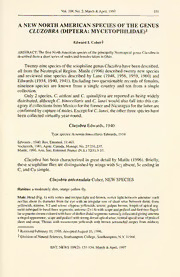Table Of ContentVol. 108,No.2,March&April, 1997 151
A NEW NORTH AMERICAN SPECIES OF THE GENUS
CLUZOBRA (DIPTERA: MYCETOPHILIDAE)!
Edward I.Coher2
ABSTRACT: The firstNorthAmericanspeciesoftheprincipallyNeotropical genusCluzobra is
describedfromashortseriesofmalesandfemalestakeninOhio.
Twenty-ninespeciesofthesciophilinegenusCluzobrahavebeendescribed,
all from the Neotropical Region. Matile (1996) described twenty new species
and reviewed nine species described by Lane (1948, 1956, 1959, 1960) and
Edwards (1934, 1940, 1941). Excluding two questionable records offemales,
nineteen species are known from a single country and ten from a single
collection.
Only 2 species, C. aitkeni and C. spinulifera are reported as being widely
distributed, although C. binocellaris and C. lanei would also fall into this cat-
egory ifcollectionsfromMexicoforthe formerandNicaraguaforthe latterare
confirmedbycaptureofmales.ExceptforC. lanei,theotherthree specieshave
beencollected virtually year-round.
Cluzobra Edwards, 1940
Typespecies:AcnemiabinocellarisEdwards, 1934
Edwards, 1940.Rev.Entomol. 11:463.
Vockeroth, 1981.Agric.Canada,Monogr.No.27:231,237.
Matile, 1996.Ann.Soc.Entomol.France(N.S.)32(l):3-57.
Cluzobra has been characterized in great detail by Matile (1996). Briefly,
these sciophiline fliesaredistinguishedby wingswithSc2absent, Scending in
C, and Cu simple.
Cluzobraantennulata Coher, NEW SPECIES
Habitus:amoderatelyslim,orange-yellowfly.
Male.Head(Fig. 1)withvertexandocciputlightred-brown,vertex lightbetweenantennae:each
ocellusaboutitsdiameterfrom theeyewith an irregularrow ofshortsetaebetween them; frons
yellowish, narrow, 5:2andsetose: clypeusyellowish, setose; palpusbrown, lengthofapical seg-
mentsubequaltobasalthreesegments;antenna(2+14)withscapeandpedicelandfirsttwoflagel-
larsegmentscream-coloredwithbaseofdarkerdistalsegmentsnarrowlyinfuscatedgivingantenna
aringedappearance;scajDCandpedicelwithstrongdorsalapicalsetae;ventralapicalsetaeofpedicel
shortandstout.Thorax with mesonotumyellowish with brown acrostichal stripes from midway
' ReceivedFebruary 10, 1995.AcceptedAugust 10, 1996.
2DivisionofNaturalSciences,SouthamptonCollege,Southampton,N.Y. 11968.
ENT.NEWS 108(2): 151-154,March&April, 1997
152 ENTOMOLOGICALNEWS
that are contiguous anteriorly with broad humeral stripes, dorsocentral stripe narrow or absent;
pleura variably pigmented yellowish orbrownish except katepistemite that is always darkerbut
lightventrally;pleurotergitewithapairoflongcentralsetae;scutellumandpostnotumconcolorous
withpleura;longscutellarsetaeinarow;posteriorpostnotumwithanirregularrowoflarge,long
setae. Wing: (3.0-3.2nim); patterned, (Fig. 2); IstAbarelydivergentfromCuandendingbeyond
fM as a line ofsetae; 2dA nearly obsolete, represented by a row ofsetae and paralleling basal
posteriorwing margin; fully trichiate. Halterwith stem yellow, knob variously pigmentedbutat
leastpartiallydarkened.Legswithcoxaebrownish,anteriorforecoxa,distal2/3ofmidcoxa,lateral
apical fourthofhindcoxasetose,hindcoxa with asingle longbasal posteriorseta; femoralighter
with tibiae and tarsi yellowish; tibial spurs long, foretibia with an apical comb; foretibia/
forebasitarsus/tarsus2,6/8/5.Abdomenorangeyellow,verysetiferous;TVIII(Fig.3): SVIII(Fig.
4).Terminalia: (Fig.5,dorsal).
Female.Descriptionasformale.Terminalia:Thepairedcerci(fig.6,c,lateral,setaeomitted),are
borneontergiteX(fig.6,TX,dorsal,)whichisbareandlightlypigmented.
Material examined: Holotype, male, Ohio: Pike Co., BentonTwp., 4/8/79, GA Dahlem. In the
collectionofMichiganSt.University.
Allotype.Female.Samedataastheholotype.
Paratopotypes: 1 maleand 1 female.
DISCUSSION
C.antennulataismostcloselyrelatedtotheBrazilianbrunneicauda.Matile,
1996 from which the male ofthe new species may be easily distinguished by
theformofitsdarkbroadlybifidinternalstyleandlackofmediandorsal styles.
The shapeofthefemalecercusisclosesttothatofC.annulicornisasfiguredby
Matile (loc. cit.), but with the apex ofthe basal cereal segment distinctly nar-
rowed in C. antennulata.
Vockeroth(1981),inakeytogeneraoftheMycetophilidae,notedaCluzobra
from Louisiana. Inquiries concerning this material have been to no avail; its
identitycannotpresently bedetermined.Thus,antennulataisthefirstNearctic
species ofCluzobra tobe described.
Biology: LimitedcapturedatasuggestthatOctobertoFebruarymaybethe
peak activity period for many of the continental South American species
although aitkeni, binocellaris and spinulifera have been collected virtually
throughout the year. Nothing is knownofthe bionomics.
ACKNOWLEDGMENTS
R.L.FischerofMichiganStateUniversitymadethismaterialavailableforstudy. Annette
Vollers preparedthe drawings.
LITERATURECITED
Edwards,F.W. 1934. New Neotropical Mycetophilidae(III). (Diptera). Rev. Entomol. 4<3):354-
372.Figs. 1-5.
Edwards,F.W. 1940.NewNeotropicalMycetophilidae(IV).(Diptera).Rev.Entomol. 11 (l-2):440-
465,Pis. 18-19.
Vol. 108,No.2,March&April, 1997 153
luzobra
C;
Plate.Cluzobraantenniilatan.sp.Fig. 1.Head,lateralview.Fig.2.Wing.Fig.3.TergiteVIII,male.
Fig.4.SVIII,male.Fig.5.Maleterminalia,dorsalaspect.Fig.6.Cercus(c, lateral)andtergiteX
(TX,dorsal),female.
154 ENTOMOLOGICALNEWS
Edwards,F.W. 1941.Mycetophilidae(Diptera)collectedbytheexpeditiontoMattoGrossoofthe
BrazilianZoologicalClub, inJuly 1939.Rev.Entomol. 12(l-2):303-314,PI. 15.
LaneJ. 1948."Mycetophilidae"do Brasil (Diptera, Nemocera). Rev. Brasil. Biol. 8(2):247-254,
Figs. 1-15.
Lane,J. 1956. New Neotropical Sciophilinae(Diptera: Mycetophilidae). Dusenia 7(3):119-124,
Figs. 1-8.
Lane,J. 1959.InsectaAmapaensia.-Diptera:Mycetophilidae.(SecondContribution).StudiaEnt.
2(1-4):105-118,Figs. 1-7.
Lane, J. 1960. Mycetophilidae from Trinidad, B.W.I. (Diptera, Nematocera). Studia Entomol.
3(l-4):375-384,Figs. 1-9.
Lane,J. 1961.FurtherNewNeotropicalMycetophilidae.(Diptera,Nematocera).Rev.Brasil.Ento-
mol. 10:1-15,Figs. 1-5.
Matile,L. 1996.RevisiondesCluzobraNeotropicaux(Diptera: Mycetophilidae).Ann.Soc.Ento-
mol. France(N.S.)32:3-57,Figs. 1-75, 1 Tbl.
Vockeroth,J.R. 1981./NManualofNearcticDipteraVol. 1.ResearchBranchAgricultureCanada,
MonographNo.27:223-246,Figs. 1-103,

